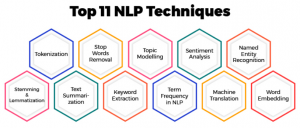Introduction:
In the dynamic landscape of modern business, where customer opinions wield immense influence, the concept of sentiment analysis has emerged as a game-changer. Sentiment analysis, a form of natural language processing, is the process of extracting emotions and opinions from text data. As businesses navigate the intricacies of customer interactions on social media, sentiment analysis stands as a powerful tool to glean insights from user feedback, unlock hidden trends, and make informed decisions that drive growth.
Defining Sentiment Analysis:
At its core, sentiment analysis involves deciphering the emotional tone embedded within words. It goes beyond mere keyword analysis, delving into the nuances of sentiment – be it positive, negative, or neutral. By utilizing machine learning algorithms, sentiment analysis categorizes feedback into these emotional dimensions, transforming raw textual data into actionable insights.

Application in Business and User Feedback:
The application of sentiment analysis in business feedback is multifaceted. In the realm of social media, where customer voices echo loudly, businesses can monitor brand perception, track campaign success, and identify emerging trends. Sentiment analysis allows businesses to quickly gauge public sentiment toward products, services, or marketing campaigns, helping them pivot strategies and maintain a competitive edge.
In the age of digital communication, social media has transformed into a treasure trove of information and insights for businesses. While tools like named-entity recognition, keyword extraction, text categorization, and predicting user preferences have revolutionized social media listening, integrating sentiment analysis adds another layer of depth to this process. This comprehensive approach not only refines businesses’ understanding of their audience but also unlocks untapped potential for development and growth.
Sentiment Analysis and other Popular NLP tools :
- Named-Entity Recognition and Sentiment Analysis: Named-entity recognition, a technique to identify and categorize entities like names, locations, and organizations within the text, is a cornerstone of information extraction. By coupling sentiment analysis with named-entity recognition, businesses can not only identify entities but also gauge the sentiments associated with them. This nuanced understanding helps organizations discern whether mentions of their brand or products are positive, negative, or neutral, enabling them to tailor responses and strategies accordingly.
- Keyword Extraction and Sentiment Insights: Keyword extraction streamlines the process of uncovering essential terms from a text corpus. By merging sentiment analysis with keyword extraction, businesses can not only identify relevant keywords but also assess the emotional context surrounding them. This approach unveils how audiences feel about particular subjects, products, or trends, allowing businesses to align their messaging with prevailing sentiments.
- Text Categorization and Comprehensive Insight: Text categorization enables the classification of text documents into predefined categories, aiding businesses in organizing large volumes of data. By infusing sentiment analysis into text categorization, businesses can further refine their understanding of customer feedback and market trends. For instance, they can categorize not just by topic, but also by the emotional tone of discussions. This enriched categorization leads to better-informed decisions and more personalized responses.
- Predicting User Preferences and Anticipating Needs: Predicting user preferences based on historical data is a goldmine for businesses aiming to deliver tailored experiences. By integrating sentiment analysis, businesses can anticipate not only what users prefer but also how they emotionally respond to certain offerings. This predictive capacity allows companies to pre-emptively address potential concerns or disappointments, curating experiences that resonate positively with their audience.

Enhancing Customer Experience:
Sentiment analysis isn’t merely a reactive tool; it’s a proactive instrument to enhance customer experience. By analyzing customer feedback, businesses can swiftly detect dissatisfaction and rectify issues before they escalate. This proactive approach not only enhances customer loyalty but also safeguards brand reputation. The amalgamation of sentiment analysis and social media listening fosters customer-centric strategies. By comprehending the sentiments associated with customer interactions, businesses can develop empathetic responses, resolve issues promptly, and amplify positive experiences. This customer-centric approach builds brand loyalty and enhances overall reputation.
Fine-Tuning Marketing Strategies:
Sentiment analysis empowers businesses to fine-tune their marketing strategies based on real-time sentiment. The ability to identify sentiment patterns surrounding specific keywords or topics helps marketers tailor their content and messaging to resonate with target audiences more effectively.

Driving Product Innovation:
Unveiling customer sentiment through sentiment analysis illuminates areas where product improvements are necessary. Businesses can identify pain points and preferences, enabling them to innovate and deliver products that align with consumer needs and desires.
Sentiment analysis complements user feedback analysis by providing insights that transcend simple categorization. Understanding customer emotions around product experiences guides informed product enhancements. For instance, negative sentiments might indicate areas for improvement, while positive sentiments can help identify features customers love.
Growth Potential and Future Landscape:
The capabilities of sentiment analysis in social networks such as YouTube are boundless in driving business growth. As machine learning algorithms evolve, sentiment analysis becomes increasingly accurate, enabling businesses to extract deeper insights. Moreover, the integration of sentiment analysis with other technologies, such as chatbots, can provide real-time customer support and engagement, further enhancing user experience.
Businesses can capitalize on sentiment analysis not only for customer feedback but also for competitor analysis. Analyzing sentiment around competitors’ products and services unveils valuable competitive insights, aiding businesses in positioning themselves more effectively.
In the future, sentiment analysis is poised to play a pivotal role in predictive analytics. By extrapolating current sentiment trends, businesses can forecast future shifts in customer preferences, allowing them to proactively adjust strategies.
The marriage of sentiment analysis with existing social media listening techniques is poised for exponential growth. As machine learning algorithms evolve, sentiment analysis will become more nuanced and accurate, providing deeper insights into user emotions. Additionally, advancements in natural language processing will empower businesses to interpret subtleties, including sarcasm and irony, further enriching the analytical process.

Conclusion:
Sentiment analysis is not merely a buzzword; it’s a strategic asset that modern businesses can’t afford to overlook. The ability to decipher customer sentiment from social media chatter equips businesses with insights that guide decision-making, enhancing customer experience, and driving growth. In an era where customers wield unprecedented influence, sentiment analysis empowers businesses to not only understand their audience but also to forge lasting connections and secure a prosperous future. As technology continues to evolve, sentiment analysis will remain a cornerstone in the toolkit of businesses seeking to thrive in the ever-evolving landscape of the digital age.
Fantastic!